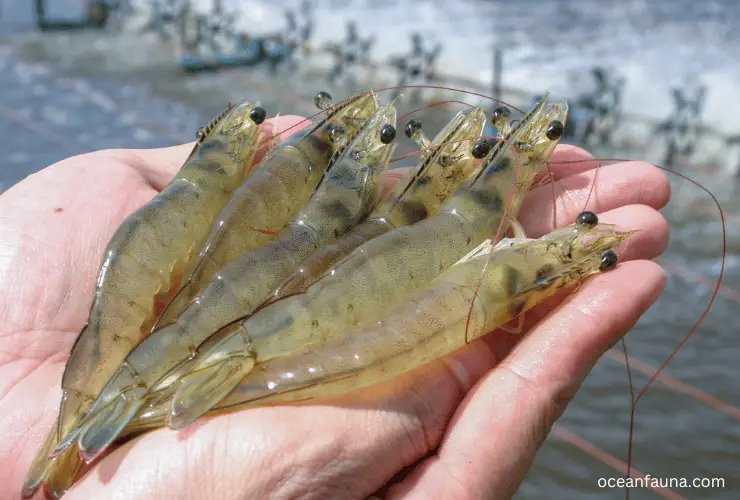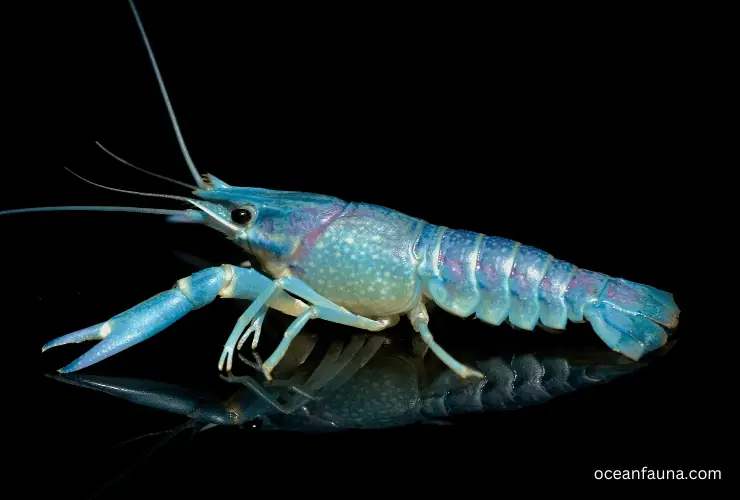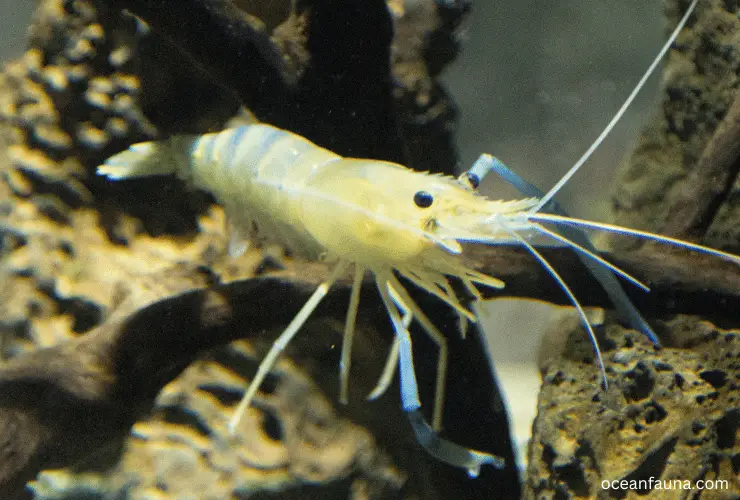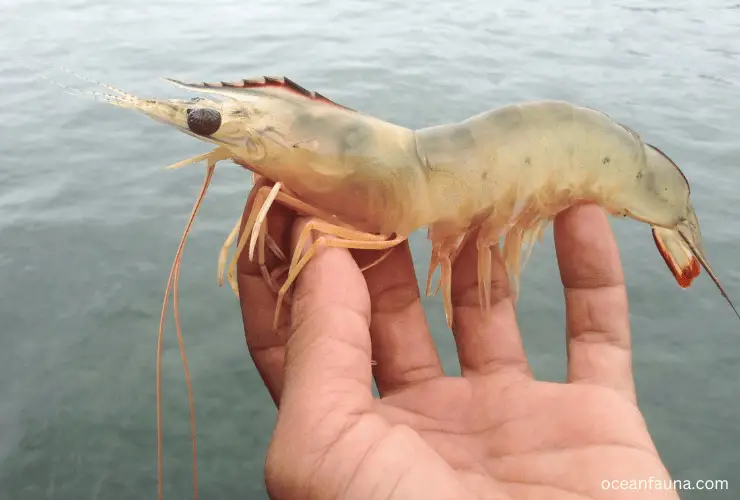No, shrimps do not have scales. However, they are covered in a hard exoskeleton-like shell that serves the same purpose as scales, protecting them from predators and environmental elements.
Now you might have a question: Why don’t shrimps have scales like fish? Well, in this article, I will discuss in detail the external shell of shrimp. Let’s get started.
Do Shrimps Have Scales?
Unlike other fish, shrimps don’t have scales. Instead, they have a tough outer layer made mostly of chitin that works like scales to protect them from predators and the environment. The exoskeleton can have multiple layers, and the outermost is known as the carapace, which acts as a sturdy shield for the shrimp.
Interestingly, the ability of shrimp to produce chitin is critical to their survival and has implications beyond their own biology. Chitin is a versatile substance that has attracted the attention of researchers for its potential applications in areas such as biomedicine, water treatment, and agriculture.
Shrimp is one of the richest natural sources of chitin, thanks to the abundance of exoskeletons shed by this ubiquitous crustacean.
In addition, some varieties of shrimp have papillae or small bumps on the exoskeleton, which can act as tiny scales and provide an additional layer of defense. These bumps also help the shrimp function in its environment by providing traction when moving across surfaces and allowing it to sense vibrations and movements nearby.

While the lack of scales on shrimp doesn’t appear to significantly impact their overall biology, it provides a useful distinction between shrimp and some other types of seafood, such as fish, which are often characterized by their scales.
It’s worth noting, however, that some species of crustaceans, such as lobsters and crabs, have scales, albeit in a different form than those found in fish.
Why Do Shrimps Don’t Have Scales?
The absence of scales on shrimp is a characteristic shared by all crustaceans and mollusk shellfish. There are several theories about this, but one popular explanation is that it offers greater flexibility and mobility for these animals. Here are more detailed discussions below.
Evolutionary Origin and Growth Pattern
The lack of scales on shrimps can be attributed to their evolutionary origin and growth pattern. Unlike fish, shrimps belong to the class Crustacea and have a hard exoskeleton made up of chitin.
This exoskeleton protects them from predators and serves as a support structure for their bodies. However, the development of scales is unnecessary for this type of exoskeleton; thus, shrimps do not have them.
Adaptation to Environment and Locomotion
Shrimps lack scales due to their adaptation to their environment, which is another reason. They are mainly aquatic animals living in different water habitats, including freshwater, saltwater, and brackish water.
Their bodies adapt to these environments, and their locomotion is achieved through appendages rather than scaly fins. The lack of scales makes their movement more efficient and allows them to easily maneuver through their habitat.
Nutritional and Digestive Reasons
Shrimps also lack scales due to nutritional and digestive reasons. Scales are mainly made up of proteins and minerals that are difficult to digest and break down.
In contrast, the exoskeleton of crustaceans and mollusk shellfish is composed of chitin, which is easily digested by certain enzymes found in the digestive system. Therefore, the absence of scales on shrimps does not hinder their nutritional value or digestibility.
Predatory Defence Mechanisms
The lack of scales on shrimps can be seen as a predatory defence mechanism. Scales provide a layer of protection against predators and make fish and other aquatic animals more visible to their predators.
Shrimps, conversely, can blend into their environment due to their lack of scales, making it easier for them to elude predators.
Do Shrimp Shed Their Exoskeleton?
Yes, shrimp do shed their exoskeleton, or outer shell, as a necessary process of growth and development. This process is called molting, which is crucial for shrimp to grow and expand. Molting helps shrimp discard their old exoskeleton and grow a new one suitable for their increased size.

During the molting process, shrimp must break free from their old exoskeleton, which can be an extremely vulnerable period for the shrimp. After shedding its shell, the shrimp’s new shell is quite soft and pliable for a short period. This period leaves them vulnerable to predators and environmental factors.
Since shrimp can grow rapidly and attain a significant size in a brief period, they must molt frequently, with young shrimp typically molting once a week. As the shrimp age, they tend to molt less frequently, but the process is equally important for their growth and survival.
The molting process is a remarkable biological occurrence that allows shrimp to expand and secure their place in their ecosystems.
Molting Process of Shrimps: How do shrimps shed their shells?
The molting process of shrimps is a crucial physiological event that allows them to grow and develop into their adult form. This process involves the shedding of their exoskeleton, a protective outer layer covering their body.
Adult shrimp molt every 3 to 4 weeks when they are in good health. However, younger shrimp tend to molt more frequently, maybe every 1 or 2 weeks, because they grow faster.
When a shrimp is ready to molt, it first absorbs water and nutrients to grow larger and break its current exoskeleton. Hormonal changes and environmental factors such as temperature and nutrition trigger this process.
As the old shell becomes too tight and constraining, the shrimp will start to split at the top just behind its head. This opening is called the cervical groove, and it allows the shrimp to bend its head and body through the gap and quickly jump out, leaving its old shell behind.
Once it has shed its old exoskeleton, the shrimp are left with a soft and vulnerable body that needs time to harden and develop a new shell. During this period, the shrimp will hide in a safe and sheltered environment, such as a burrow or vegetation, to avoid predators and other threats.
As the new shell develops, the shrimp will absorb minerals and nutrients from its surroundings to strengthen and harden it. This process can take several days or even weeks, depending on the size and species of shrimp.
After the new shell is fully formed and hardened, the shrimp will emerge from its hiding place and resume normal activities. It will then continue to grow and develop until it is ready to molt again, repeating the cycle of shedding its exoskeleton and growing a new one.
Overall, the molting process of shrimps is a complex and fascinating phenomenon that highlights their remarkable adaptability and resilience. Shrimps can overcome physical limitations and continue to thrive in their aquatic habitats by shedding their old shells and growing new ones.
Do Shrimps Have Fins?
No, shrimps do not have fins. While fins are a common characteristic of many aquatic animals, such as fish and dolphins, shrimps have adapted to swim without them. Instead, they rely on their belly and tail muscles to propel themselves through the water.

One reason shrimps don’t have fins is because of their body structure. Unlike many other aquatic animals, shrimps have a very small, compact body unsuitable for larger appendages like fins.
Additionally, shrimps have a hard exoskeleton, limiting their ability to flex and move in certain ways.
However, despite not having fins, shrimps are still excellent swimmers. They can use their unique body shape and swimming method, which involves rapidly flexing their tail to propel themselves forward. In fact, shrimps have been known to swim at impressive speeds and can cover large distances in a relatively short amount of time.
What Is Good About Shrimp Shells?
The shrimp shell is often overlooked, yet it is a highly nutritious and beneficial part of the shrimp. Here are some of the key benefits of shrimp shells:
Protects shrimp from predators:
The thick exoskeleton of the shrimp shell helps protect it from predators, and its hard exterior also discourages scavengers.
Rich in Nutrients
Shrimp shells are a rich source of lean protein, healthy fats, and minerals such as calcium, phosphorus, and magnesium. According to research, the shells of some shrimp species can contain up to 38% protein by weight. The shells also contain chitin, a type of fiber that is beneficial to gut health.
Boosts Immunity
Consuming shrimp shells regularly can help to boost immunity. The shells contain a compound called astaxanthin, which has antioxidant properties. Antioxidants help to protect the body against oxidative stress caused by free radicals, which can damage cells and tissues.
Aids in Weight Loss
Shrimp shells can aid in weight loss thanks to their high protein content and low calorie count. Protein is known to be satiating, which can help keep you full for longer and reduce cravings. Additionally, the chitin in shrimp shells has been shown to bind with dietary fat, reducing the amount that is absorbed by the body.
Promotes Brain and Heart Health
Shrimp shells contain omega-3 fatty acids essential for brain and heart health. Omega-3s have been shown to reduce inflammation in the body and improve cognitive function. They are also important for maintaining a healthy heart by reducing the risk of heart disease and stroke.
Benefits the Soil
Shrimp shells are not only beneficial for human consumption but also for gardening. They can be added to compost to enrich the soil with essential nutrients. Shrimp shells contain compounds that feed bacteria and fungi, which help break down soil organic matter and improve soil health.
FAQs
Is shrimp an endoskeleton or an exoskeleton?
Shrimp has an exoskeleton. This hard outer shell protects the shrimp and also helps them move through the water by providing a resistant surface against which their muscles can push.
Do shrimps have gills?
Yes. Shrimp possess gills to extract oxygen from the water to respire.
Conclusion
Now, you have complete knowledge regarding the outer shell of shrimps. The shrimp shell is often overlooked, yet it is a highly nutritious and beneficial part of the shrimp.
It protects them from predators and offers numerous health benefits for humans, such as boosting immunity, aiding in weight loss, promoting brain and heart health, and enriching soil with essential nutrients. All these factors make shrimps an integral part of marine life.
Let me know if you have any further queries regarding the shrimp shell. I will answer them as soon as possible.

